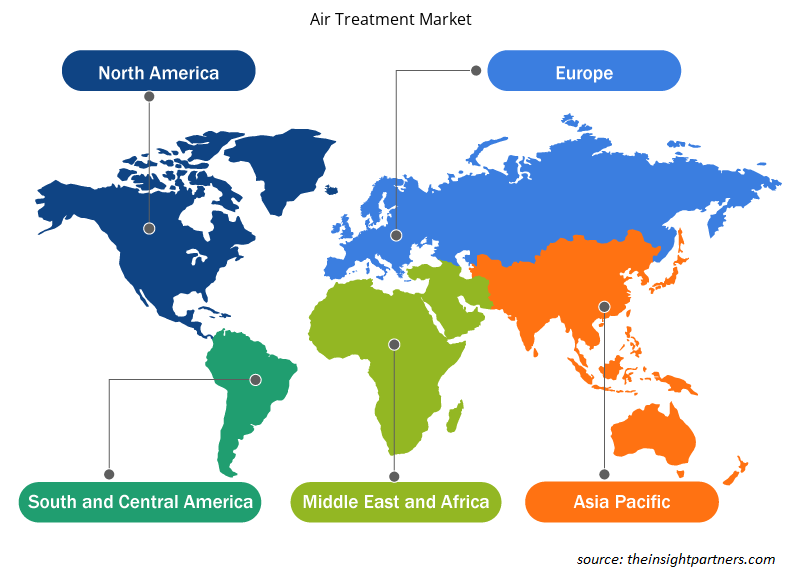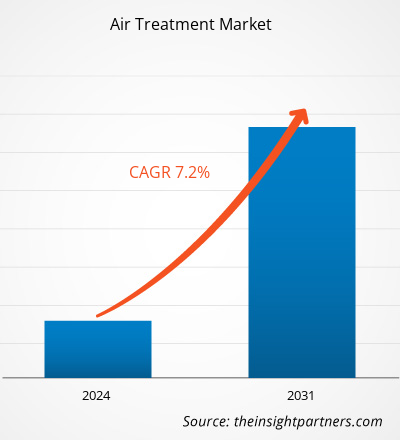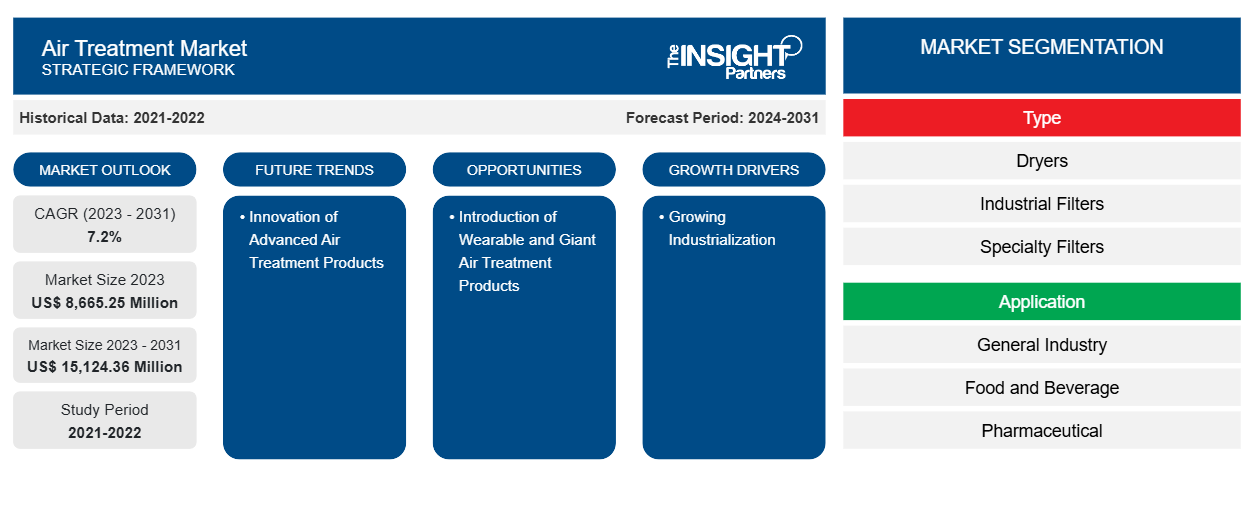Le marché du traitement de l'air devrait atteindre 15 124,36 millions USD d'ici 2031, contre 8 665,25 millions USD en 2023. Le marché devrait enregistrer un TCAC de 7,2 % au cours de la période 2023-2031. L'innovation des produits avancés de traitement de l'air devrait rester une tendance clé du marché.
Analyse du marché du traitement de l'air
Les principaux utilisateurs finaux du marché du traitement de l'air sont les secteurs de l'énergie, de l'alimentation et des boissons et de la pétrochimie. La croissance urbaine devrait avoir lieu dans les bidonvilles et autres zones construites de manière informelle des États et des pays dans les années à venir. En outre, les conditions de croissance favorables à l'échelle mondiale et la croissance des projets d'infrastructure ont propulsé le taux de croissance du marché du traitement de l'air à l'échelle mondiale.
Aperçu du marché du traitement de l'air
Les principaux acteurs de l'écosystème du marché mondial du traitement de l'air comprennent les fournisseurs de matériel/composants, les fabricants/fournisseurs de traitement de l'air et les utilisateurs finaux. Les fournisseurs de composants/matériels fournissent divers composants/pièces/matières premières aux fabricants de traitement de l'air pour la fabrication du produit final. Différents types de matières premières sont utilisés pour fabriquer des produits de traitement de l'air. Parmi les principaux fabricants du marché mondial du traitement de l'air figurent ABIONIK Group GmbH, Beko Technologies, Donaldson Company, Inc., Condorchem Envitech, Parker Hannifin, Kaesar Kompressoren, Mikropor, Odatech Pty Ltd., SPX FLOW, Inc. et Xebec Adsorption Inc., entre autres.
Personnalisez ce rapport en fonction de vos besoins
Vous bénéficierez d'une personnalisation gratuite de n'importe quel rapport, y compris de certaines parties de ce rapport, d'une analyse au niveau des pays, d'un pack de données Excel, ainsi que de superbes offres et réductions pour les start-ups et les universités.
- Obtenez les principales tendances clés du marché de ce rapport.Cet échantillon GRATUIT comprendra une analyse de données, allant des tendances du marché aux estimations et prévisions.
Facteurs moteurs et opportunités du marché du traitement de l'air
L'industrialisation croissante favorise le marché
L'industrie du traitement de l'air est directement ou indirectement portée par des mesures gouvernementales vigoureuses visant à soutenir le secteur industriel, telles que celles prises par de grandes régions comme l'Amérique du Nord et l'Europe, à travers divers forums. Les politiques européennes sont bénéfiques pour le développement des entreprises, ce qui est l'une des raisons de la croissance de l'industrie électronique et des PME en Europe. La formation de la région UE a facilité les affaires, les importations et les exportations entre les membres de l'Union. Ces industries sont très courantes dans cette région. Ainsi, le développement croissant du secteur industriel oriente la demande du marché du traitement de l'air à l'échelle mondiale.
Présentation des produits de traitement de l'air portables et géants
Les systèmes de filtration de l'air sont installés pour assurer la sécurité sur les lieux de travail industriels. La tendance croissante des systèmes de traitement de l'air permet de capturer les plus petites particules de fumée dans les zones industrielles. La fabrication avancée des métaux s'appuie sur une technologie de pointe et des processus d'automatisation pour produire des produits qui libèrent des processus de chauffage, des gaz nocifs et des fumées en tant que sous-produit du soudage. Cela a alimenté l'installation de systèmes de dépoussiérage avec des cartouches de filtration de haute qualité. L'avènement croissant des produits de traitement de l'air portables et géants dans le secteur industriel est l'un des principaux fournisseurs d'opportunités de croissance pour le marché dans les années à venir.
Analyse de segmentation du rapport sur le marché du traitement de l'air
Les segments clés qui ont contribué à l’élaboration de l’analyse du marché du traitement de l’air sont le type et l’application.
- En fonction du type, le marché du traitement de l'air est divisé en sécheurs, filtres industriels, filtres spécialisés et gestion des condensats. Le segment des filtres industriels détenait une part de marché plus importante en 2023.
- En termes d'application, le marché est segmenté en industrie générale, agroalimentaire, pharmaceutique, pétrole et gaz, chimie et pétrochimie et exploitation minière. Le segment pharmaceutique détenait une part importante du marché en 2023.
Analyse des parts de marché du traitement de l'air par zone géographique
La portée géographique du rapport sur le marché du traitement de l’air est principalement divisée en cinq régions : Amérique du Nord, Asie-Pacifique, Europe, Moyen-Orient et Afrique, et Amérique du Sud et centrale.
L'Amérique du Nord est en tête du marché. La population des États-Unis a un niveau de vie élevé et la capacité de dépense des gens est également immense en raison du revenu par habitant élevé du pays. Cela se traduit par l'utilisation de plus d'installations et augmente la consommation de ressources dans la région. Cela entraînera en outre un besoin croissant d'air frais dans le pays, influençant ainsi la croissance du marché du traitement de l'air. L'Amérique du Nord est une région technologiquement avancée. Les purificateurs d'air intelligents ont connu une forte adoption dans cette région. Ces technologies, lorsqu'elles sont intégrées aux machines, offrent des gains d'efficacité aux utilisateurs finaux. Un plus grand nombre de déploiements nécessite une plus grande concurrence dans la région ainsi que la croissance de l'ensemble du secteur conduisant au développement du marché et aux innovations.
Aperçu régional du marché du traitement de l'air
Les tendances et facteurs régionaux influençant le marché du traitement de l’air tout au long de la période de prévision ont été expliqués en détail par les analystes d’Insight Partners. Cette section traite également des segments et de la géographie du marché du traitement de l’air en Amérique du Nord, en Europe, en Asie-Pacifique, au Moyen-Orient et en Afrique, ainsi qu’en Amérique du Sud et en Amérique centrale.

- Obtenez les données régionales spécifiques au marché du traitement de l'air
Portée du rapport sur le marché du traitement de l'air
| Attribut de rapport | Détails |
|---|---|
| Taille du marché en 2023 | 8 665,25 millions de dollars américains |
| Taille du marché d'ici 2031 | 15 124,36 millions de dollars américains |
| Taux de croissance annuel composé mondial (2023-2031) | 7,2% |
| Données historiques | 2021-2022 |
| Période de prévision | 2024-2031 |
| Segments couverts | Par type
|
| Régions et pays couverts | Amérique du Nord
|
| Leaders du marché et profils d'entreprises clés |
|
Densité des acteurs du marché : comprendre son impact sur la dynamique des entreprises
Le marché du traitement de l'air connaît une croissance rapide, tirée par la demande croissante des utilisateurs finaux en raison de facteurs tels que l'évolution des préférences des consommateurs, les avancées technologiques et une plus grande sensibilisation aux avantages du produit. À mesure que la demande augmente, les entreprises élargissent leurs offres, innovent pour répondre aux besoins des consommateurs et capitalisent sur les tendances émergentes, ce qui alimente davantage la croissance du marché.
La densité des acteurs du marché fait référence à la répartition des entreprises ou des sociétés opérant sur un marché ou un secteur particulier. Elle indique le nombre de concurrents (acteurs du marché) présents sur un marché donné par rapport à sa taille ou à sa valeur marchande totale.
Les principales entreprises opérant sur le marché du traitement de l'air sont :
- Beko Technologies
- Société Donaldson, Inc.
- Parker Hannifin
- Honeywell International Inc
- Hongrijia Depurate Facility Science & Technology Co., Ltd.
- Ingersoll Rand Inc.
Avis de non-responsabilité : les sociétés répertoriées ci-dessus ne sont pas classées dans un ordre particulier.

- Obtenez un aperçu des principaux acteurs du marché du traitement de l'air
Actualités et développements récents du marché du traitement de l'air
Le marché du traitement de l'air est évalué en collectant des données qualitatives et quantitatives après des recherches primaires et secondaires, qui comprennent des publications d'entreprise importantes, des données d'association et des bases de données. Quelques-uns des développements du marché du traitement de l'air sont répertoriés ci-dessous :
- Ingersoll Rand Inc., fournisseur mondial de solutions industrielles et de création de flux critiques, a finalisé l'acquisition de Friulair Srl (« Friulair ») pour un prix d'achat initial entièrement en espèces d'environ 146 millions de dollars américains. (Source : Ingersoll Rand Inc., communiqué de presse, février 2024)
- Honeywell International Inc. a lancé son moniteur de qualité de l'air intérieur (QAI), qui alerte les propriétaires et les exploitants de bâtiments des problèmes potentiels afin d'améliorer de manière proactive la qualité de l'air intérieur, réduisant ainsi potentiellement le risque de transmission de contaminants en suspension dans l'air. (Source : Honeywell International Inc., communiqué de presse, février 2022)
Rapport sur le marché du traitement de l'air et livrables
Le rapport « Taille et prévisions du marché du traitement de l’air (2021-2031) » fournit une analyse détaillée du marché couvrant les domaines ci-dessous :
- Taille et prévisions du marché du traitement de l'air aux niveaux mondial, régional et national pour tous les segments de marché clés couverts par le périmètre
- Tendances du marché du traitement de l'air ainsi que la dynamique du marché telles que les facteurs moteurs, les contraintes et les opportunités clés
- Analyse PEST et SWOT détaillée
- Analyse du marché du traitement de l'air couvrant les principales tendances du marché, le cadre mondial et régional, les principaux acteurs, les réglementations et les développements récents du marché
- Analyse du paysage industriel et de la concurrence couvrant la concentration du marché, l'analyse de la carte thermique, les principaux acteurs et les développements récents du marché du traitement de l'air
- Profils d'entreprise détaillés
- Analyse historique (2 ans), année de base, prévision (7 ans) avec TCAC
- Analyse PEST et SWOT
- Taille du marché Valeur / Volume - Mondial, Régional, Pays
- Industrie et paysage concurrentiel
- Ensemble de données Excel
Rapports récents
Témoignages
Raison d'acheter
- Prise de décision éclairée
- Compréhension de la dynamique du marché
- Analyse concurrentielle
- Connaissances clients
- Prévisions de marché
- Atténuation des risques
- Planification stratégique
- Justification des investissements
- Identification des marchés émergents
- Amélioration des stratégies marketing
- Amélioration de l'efficacité opérationnelle
- Alignement sur les tendances réglementaires





















 Obtenez un échantillon gratuit pour - Marché du traitement de l'air
Obtenez un échantillon gratuit pour - Marché du traitement de l'air